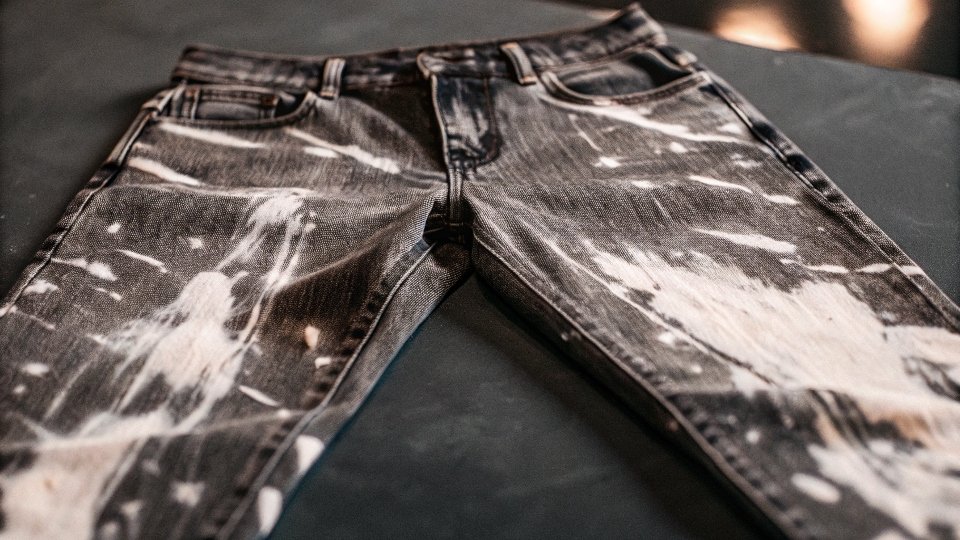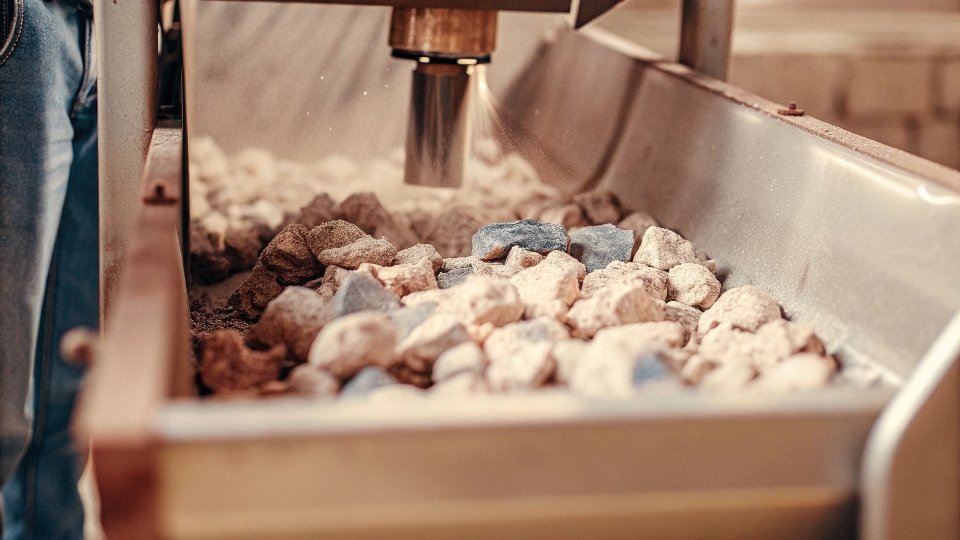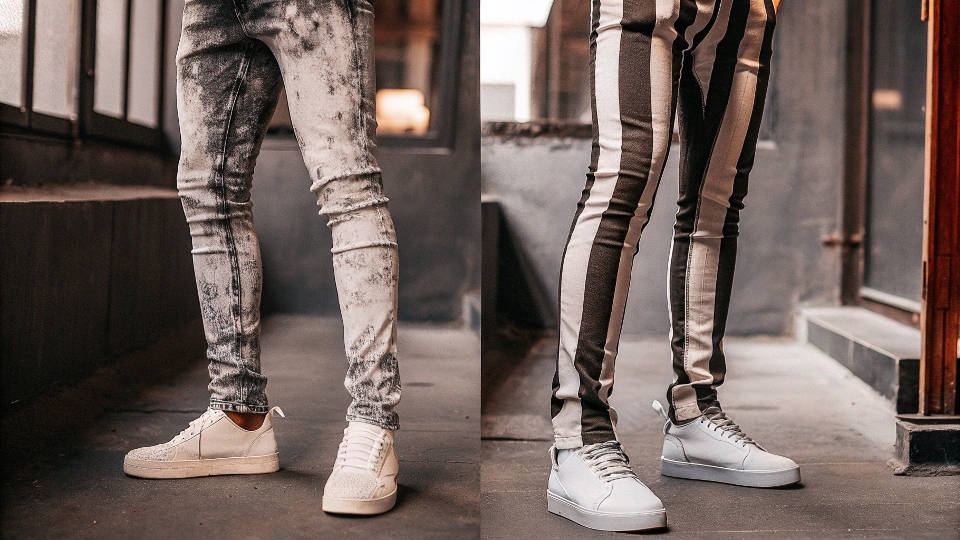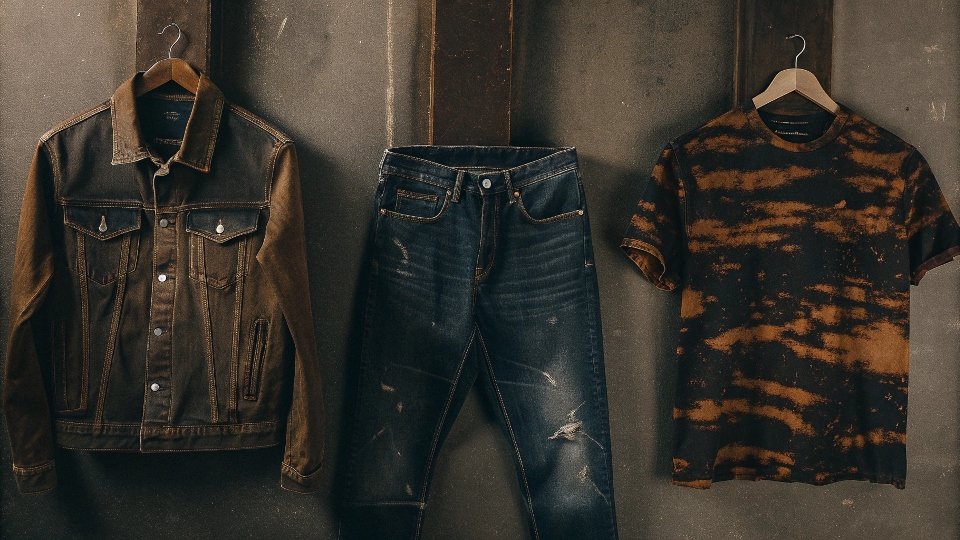You love the edgy, unique look of acid wash jeans1 but think it's too complicated to do yourself. You have a plain pair of jeans you'd like to transform, but you're afraid of ruining them.
To make acid wash jeans at home, you need to bind your jeans tightly with rubber bands2, then apply a 1:1 mixture of bleach and water. Let it sit for 15-30 minutes, then rinse and wash thoroughly. Always work in a well-ventilated area3 with gloves.
The acid wash look is an icon of denim finishing. In my 20 years running the DiZNEW denim factory, I've seen this style come in and out of fashion several times, and right now, it's back in a big way.
The process we use in the factory is a bit different and more controlled, often using pumice stones4 soaked in chemicals.
But the basic principle is the same: you create a resist pattern on the fabric and then strategically remove color.It’s a fun and creative project that can give a forgotten pair of jeans an exciting new life.
How to turn jeans into acid wash?
You have a perfect pair of jeans for this project, but you need clear, simple instructions. You want to give them that cool, edgy acid wash look, but you don't know exactly where to start.
First, get your 100% cotton jeans damp and find a ventilated space. Tightly scrunch and tie them with rubber bands. Spray with a 50/50 bleach and water mix, wait 15-30 minutes, then rinse in cold water before washing them alone.
The key to a great acid wash pattern is in the prep work. The way you fold, twist, and bind the jeans will determine the final look.
Tighter scrunching with more rubber bands will create a more defined, high-contrast pattern5. A looser scrunch will result in a softer, cloud-like effect. It's crucial not to let the bleach sit for too long, as it can weaken and damage the cotton fibers of the denim. I always tell people to stand and watch the color change6 in real time.
Once you see a color you like, immediately stop the process by rinsing the jeans thoroughly in cold water. This gives you complete creative control.
Step-by-Step DIY Acid Wash Guide
| Step | Action | Pro Tip |
|---|---|---|
| 1. Preparation | Wash jeans. In a well-ventilated area, put on gloves and eye protection. | Working with slightly damp jeans helps the bleach mixture spread more evenly for a softer look. |
| 2. Bind Jeans | Tightly scrunch, twist, or fold your jeans and secure with rubber bands. | The tighter the bands, the more dark blue will be left behind, creating more contrast. |
| 3. Mix Solution | In a spray bottle, mix one-part household bleach with one-part water. | For a stronger effect, you can use slightly more bleach, but never exceed a 2:1 ratio. |
| 4. Apply | Evenly spray the bleach solution onto the bound jeans. Don't completely soak them. | Flip the bundle over and spray the other side to ensure coverage. |
| 5. Wait & Watch | Let the jeans sit for 15-30 minutes, checking the color change frequently. | The color will lighten further after washing. Stop when it's a shade or two darker than you want. |
| 6. Rinse & Wash | Wearing gloves, remove bands and rinse jeans thoroughly in cold water. Then, wash them alone. | A final wash with a bit of white vinegar can help neutralize any lingering bleach smell. |
How are acid washed jeans made?
You've seen the DIY method, but now you're curious how professionals get it done. You wonder what kind of process happens inside a factory to produce that consistent, classic look on a large scale.
Professionally, acid washed jeans are made by tumbling dry jeans with pumice stones soaked in a bleaching agent, typically potassium permanganate. This is a waterless process where the stones abrade the denim and transfer the chemical, creating the marbled effect.
This industrial method is fascinating and very different from the home version. The term "acid wash" is actually a bit misleading because no acid is used.
The key is the combination of chemical action and physical abrasion. We start by soaking porous volcanic pumice stones in a potassium permanganate solution until they are fully saturated.
We then drain the excess liquid. These chemical-laden stones are placed into a huge industrial washing machine with the dry jeans. As the machine tumbles, the stones rub against the denim, scraping the surface and applying the bleaching agent only on the highest points.
This creates that iconic, random marbling with deep blue in the crevices. After tumbling, the jeans go through several water-only wash and rinse cycles to neutralize the chemical and wash out all the pumice dust.
How to make acid wash effect?
You love the acid wash look but want to have more control over the final pattern. You're afraid of just scrunching it up and ending up with a messy, unintentional result.
To control the acid wash effect, you must focus on your binding technique. Tight, random scrunching creates the classic mottled look. Accordion-folding and clamping the jeans before spraying will produce sharp, linear stripes for a more modern, graphic pattern.
The binding is where your artistry comes in. The fabric that is folded and protected by rubber bands or clamps acts as a "resist," preventing the bleach from reaching it. This is what creates the pattern.
Think of yourself as a sculptor, creating high points that will be bleached and low points that will remain dark. For a softer, more subtle effect, you can skip the binding altogether and just lightly spray the bleach solution onto flat jeans.
For a very targeted application, dip a sponge or brush into the bleach mixture and dab it on exactly where you want the effect to appear. Experimenting with different folding and application methods is the best way to develop your own unique style.
How to make clothes look acid washed?
You've mastered the technique on jeans and now want to apply this cool effect to other clothes. You're wondering if the process works on other fabrics and colors, like a black cotton hoodie.
Yes, you can acid wash other natural fiber clothing. The process is the same, but the results vary with color. On black or dark-colored cotton, bleach will lift the dye to a rusty orange, pink, or tan color, not white.
This technique is not just for blue jeans, but fabric choice is critical. It works best on 100% natural fibers like cotton, linen, or rayon.
You must avoid using bleach on synthetic fibers like polyester, nylon, or spandex, as it can melt them or damage them severely. Even on jeans, we at the factory are careful with styles that have a high stretch content.
The most important thing to remember is that bleach removes color; it doesn't add white. The final color you get depends on the base dye that was originally used.
A black t-shirt was likely dyed with a black dye that has a red or orange base, which is what you're left with when the bleach strips the top layer of color away.
Always test a small, hidden spot first to see what color you will get before committing to the whole garment.
Conclusion
Creating acid wash jeans at home is an easy and fun DIY project. With bleach, water, and some creative folding, you can transform old clothes. Just remember to work safely with natural fibers.
-
Explore the history and style of acid wash jeans, a timeless fashion statement that adds character to any outfit. ↩
-
Discover how different binding techniques with rubber bands can create unique and stunning acid wash patterns. ↩
-
Understand the safety precautions necessary when working with bleach and why ventilation is crucial. ↩
-
Understand the industrial process of acid washing and how pumice stones contribute to the iconic look of denim. ↩
-
Discover the techniques that lead to striking high-contrast designs in your acid wash projects. ↩
-
Delve into the science behind how bleach interacts with dye in denim to create stunning color transformations. ↩











